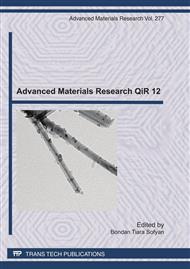[1]
I. Y. Guzman, Certain principles of formation of porous ceramic structures. Properties and Application (A review), Glass and Ceramic, vol. 60, no. 9 – 10, p.280 – 283, (2003).
DOI: 10.1023/b:glac.0000008227.85944.64
Google Scholar
[2]
P. Maheswari, N. Venilamani, S. Madhavakrishnan, P.S. Syedshabudden, R. Venckatesh, S. Pattabhi, Utilization of sago waste as an adsorbent for the removal of Cu (II) ion from aqueous soulution, E-journal of Chemistry, vol. 5, no. 2, p.233 – 242, (2008).
DOI: 10.1155/2008/376839
Google Scholar
[3]
R. Wahi, D. Kanakarazu, N. A. Yusuf, Preliminary study on zinc removal from aqueous solution by sago waste, Global Journal of Environmental Research, vol. 4, p.127 – 134, (2010).
Google Scholar
[4]
H. Aripin, L. Lestari, D. Ismail, S. Sabchevski, Sago waste based activated carbon film for electrode material of electric double layer capacitor (EDLC), The Open Materials Science Journal, vol. 4, p.117 – 124, (2010).
DOI: 10.2174/1874088x01004010117
Google Scholar
[5]
H. Aripin, S. Mitsudo, S. Tani, K. Sako, Y. Fujii, T. Saito, T. Idehara, Fabrication of Unglazed Clay Ceramic Tile using Sago Waste as a Prospective Additive Material with Controllable Milling, submitting to The Open Materials Science Journal.
DOI: 10.2298/sos1401055a
Google Scholar
[6]
H. Aripin, S. Mitsudo, S. Tani, K. Sako, Y. Fujii, T. Saito, T. Idehara, Fabrication of unglazed ceramic tile using dense structured sago waste and clay composite, Indonesian Journal of Material Science, vol. 11, no. 2, pp.79-82, (2010).
DOI: 10.2298/sos1401055a
Google Scholar
[7]
H. Aripin, S. Mitsudo, I.N. Sudiana, S. Tani, K. Sako, Y. Fujii, T. Saito, T. Idehara, Rapid Sintering of Silica Xerogel Ceramic derived from Sago Waste Ash Using Submillimeter Wave Heating of a 300 GHz CW Gyrotron, submitting to International Journal of Infrared, Millimeter and Terahertz Waves.
DOI: 10.1007/s10762-011-9797-2
Google Scholar
[8]
D.G. Pinatti, R.A. Conte, M.C. Borlini, B.C. Santos, I. Oliveira, C.M.F. Vieira, S.N. Monteiro, Incorporation of the ash from cellulignin into vitrified ceramic tile, Journal of the European Ceramic Society, vol. 26, p.305 – 310, (2006).
DOI: 10.1016/j.jeurceramsoc.2004.11.009
Google Scholar
[9]
X. Lingling, G. Wei, W. Tao, Y. Nanru, Study on fired bricks with replacing clay by fly ash in high volume ratio, Construction Building Material, vol. 19, p.243 – 247, (2005).
DOI: 10.1016/j.conbuildmat.2004.05.017
Google Scholar
[10]
C. Bray, Ceramic and Glass, A Basic Technology, Society of Glass Technology, Sheffield, (2000).
Google Scholar
[11]
E. M Levin, C. R Robbins, H. F McMurdie, Phase diagrams for ceramics, The American Ceramic Society, vol. 1, p.219 – 241, (1964).
Google Scholar
[12]
Y. Sheng-Han, J. Bao Li, B. Chi, Z. Win Wen, Effect of sintering temperature on porous silica composite strength, Journal of Porous Material, vol. 10, p.41 – 45, (2003).
Google Scholar


